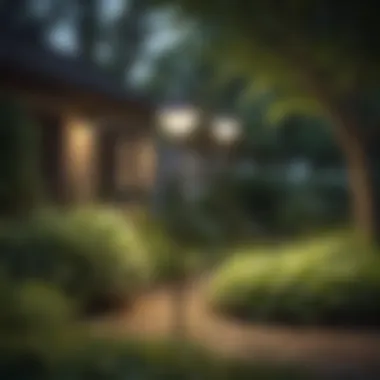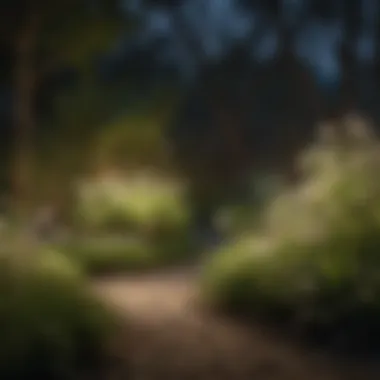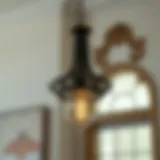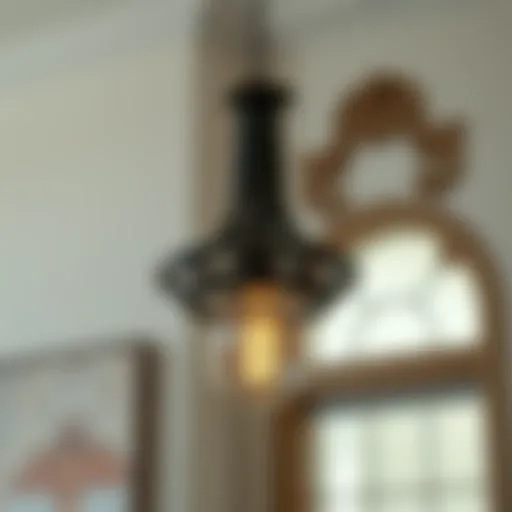Understanding LED Prices for Garden Lighting Solutions


Intro
Diving into the world of garden lighting can feel like navigating a maze, especially with the rise of LED technology. What makes this topic particularly engaging is the array of options available, each tailored to meet distinct tastes and needs. Homeowners and landscape designers want to convey specific moods and atmospheres as they illuminate their outdoor spaces. With LED lights becoming the go-to choice due to their energy efficiency and longevity, understanding pricing is crucial for making informed decisions.
As we embark on this exploration of garden light LED prices, several questions arise. What drives the costs up or down? Are there particular features that justify higher prices? It's essential to peel back the layers of the market trends while examining how various attributes, from lumens to color temperatures, impact pricing. Armed with knowledge, homeowners can illuminate their areas without breaking the bank and designers can craft visually striking landscapes.
This discussion opens a window into the marketplace, empowering readers to sift through the noise and select the best options that match their needs. The journey entails a deep dive into both aesthetic elements and practical considerations. Let’s shed some light on the purchase choices awaiting those keen to enhance their outdoor ambience.
Prelims to Garden Lighting
Garden lighting isn't just about illuminating a space after the sun goes down; it sets the mood, highlights features, and can even enhance safety. For homeowners and designers alike, understanding how to properly light outdoor areas is crucial. The right lighting can transform a garden from a simple patch of grass and plants into a sanctuary that beckons visitors to linger.
This section explores foundational elements of garden lighting, emphasizing why a thoughtful approach is necessary. From the selection of fixtures to the overall design layout, lighting decisions can drastically affect an outdoor area's overall aesthetic.
Choosing the right garden lights contributes not only to beauty but also to functionality, making evenings welcoming and enjoyable.
The Role of Lighting in Outdoor Spaces
Outdoor lighting has practical benefits, but its impact goes beyond utility. It shapes the experience, guiding the eye to focal points while creating pathways for safety. Imagine a garden at dusk; paths lit gently by soft lights make navigation a breeze. Placing spotlights on trees or sculptures can draw attention to your landscaping efforts, transforming mundane areas into showcases.
Also, consider how light interacts with materials and colors. Warm lights can enhance the earthy tones of wooden structures or the vibrancy of flowers, evoking different emotions at various times. When done right, lighting can also extend the usability of outdoor spaces, turning a cozy nook into a relaxing evening retreat.
"Lighting is a crucial storyteller in garden spaces, influencing how one perceives beauty and function simultaneously."
Thus, when selecting garden lights, it’s wise to consider both ambiance and practicality. Homeowners should prioritize versatility in their choices, ensuring lights can adapt to the changing needs of their space as the seasons shift.
Evolution of Garden Lighting Solutions
The journey of garden lighting has been nothing short of remarkable. In the early days, homeowners relied on candles or oil lamps, which, quite frankly, offered limited effectiveness and posed significant fire hazards. Fast forward to today, and we have a dazzling array of options. With innovations in technology, homeowners can choose from solar-powered solutions, wired systems, and the increasingly popular LED lights.
LED garden lights, in particular, have revolutionized the market. Offering long lifespan, energy efficiency, and a range of designs, LEDs stand out as a dynamic choice for modern gardens. Recent trends favor smart technology as well, with options for remotely controlling lights and integrating them into smart home systems. This evolution has led not just to improved aesthetics but also to energy-conscious choices that resonate with environmentally minded consumers.
That said, navigating this range of products can be overwhelming. A designer must stay current with trends and technical specifications to provide the best recommendations. Balancing aesthetics with function continues to be the crux of garden lighting evolution, and this part of the industry only promises to grow more exciting in the future.
Understanding LED Technology in Garden Lights
When considering garden lighting, understanding LED technology is crucial for making informed purchasing decisions. LEDs, or Light Emitting Diodes, have revolutionized the way we illuminate outdoor spaces. Their efficiency and versatility come with a host of advantages that cater not just to aesthetics but also to sustainability.
Basics of LED Technology
LEDs are semiconductor devices that emit light when an electrical current passes through them. Unlike traditional incandescent bulbs that require a filament and produce heat, LEDs are much cooler and more energy-efficient. Their lifespan can stretch up to 25,000 hours or more, which drastically reduces the need for frequent replacements. This makes them a smart choice for garden lighting, where energy efficiency is essential.
In terms of brightness, LEDs are measured in lumens, and they can be designed to emit a wide range of colors. With the right choice of color temperature, from warm yellow to cool white, they can create different moods in your garden, effectively enhancing various features like flower beds or pathways.
Advantages of Using LED Lights
Using LED lights in your garden offers myriad benefits that go beyond mere illumination. Here are some key points:
- Energy Efficiency: One of the standout features of LEDs is their energy efficiency. They consume significantly less power than incandescent or halogen bulbs, leading to lower electricity bills.
- Longevity: As mentioned earlier, LED lights have a remarkably long lifespan. This durability translates to fewer replacements, saving you money and hassle over time.
- Reduced Heat Emission: LEDs emit very little heat, making them safer to use, particularly in areas with flammable materials. This feature is particularly important in gardens where dry leaves or mulch may be present.
- Environmental Impact: Using LEDs reduces your carbon footprint. They contain no harmful materials, unlike some other types of bulbs, meaning they are safer to dispose of.
- Variety of Designs: There's a diverse array of LED garden lights available, from string lights to spotlights, allowing you to match your garden lighting to its style and your personal taste.
"Switching to LED garden lights isn’t just an upgrade; it’s a step towards both beauty and sustainability in your outdoor spaces."
The benefits of LED technology resonate deeply with homeowners, designers, and enthusiasts alike. With growing environmental awareness and a focus on energy efficiency, opting for LED garden lights is increasingly seeing acceptance not only for their practicality but also for their contribution to greener living.
Market Overview of Garden Lights
Understanding the market landscape for garden lights, especially LEDs, plays a crucial role in making informed choices. As outdoor spaces evolve into extensions of our living environments, the importance of lighting has increased. LED garden lights not only enhance the ambience but also offer practical benefits such as energy efficiency and longevity. Moreover, the variety in pricing and features can be overwhelming, thus clarifying this landscape helps homeowners and designers alike navigate their options effectively.
Current Market Trends
The garden light sector has seen noticeable shifts due to the growing awareness of sustainable practices and energy-efficient products. Here are some key trends:
- Sustainability Focus: There is a burgeoning demand for eco-friendly options. Consumers are gravitating towards solar-powered lights and those made from recyclable materials. This pulls at the heartstrings of eco-conscious buyers, showcasing their commitment to reducing their carbon footprint.
- Technological Advancements: Smart lighting systems are becoming commonplace. Homeowners can control their garden lights from their smartphones, enabling them to adjust settings remotely. It’s as if your garden is coming to life, responding to your command.
- Increased Customization: Many manufacturers now offer customizable solutions that allow for tailored brightness, color, and design. This trend aligns with individual preferences, making it easier for each person to create their unique backyard oasis.
- Affordability and Accessibility: The entry prices for quality LED lights have decreased significantly. With a growing number of brands in the market, competition has led to a drop in prices, making garden lighting more accessible than ever before.
"The modern garden light market is not just about illumination; it’s about enhancing lifestyle while considering environmental impact."
Key Players in the LED Garden Light Market
With this expanding market, several brands have emerged as leaders, steering the direction of innovation and quality. Notably:


- Philips: Renowned for its wide selection of garden lighting solutions, this brand emphasizes energy efficiency and durability. Their lights often stand the test of time, providing reliable performance.
- GE Lighting: A veteran in the lighting industry, GE offers an array of smart garden lights, putting a premium on user-friendly technology.
- Ring: Famed for its security products, Ring extends its expertise into garden lighting, offering solutions that integrate with home security systems.
- Solatube: As a strong proponent of solar energy, Solatube specializes in solar-powered garden lights, perfect for those looking to harness natural resources.
- Ecosmart: This brand focuses on sustainability while providing innovative lighting solutions, blending aesthetics with environmental consciousness.
Each of these players brings something unique to the table, fostering a competitive spirit that ultimately benefits the consumer. Understanding these dynamics allows potential buyers to make choices that not only fit their budgets but also align with their ethical and aesthetic values.
Factors Influencing Garden Light LED Prices
Understanding the various factors that shape the prices of garden light LEDs is crucial for anyone looking to make a purchase. The price tags attached to these lighting solutions can mainly vary based on their specific features, quality, and brand recognition. Knowing what influences these costs can help buyers make better, more informed choices that suit their budget and requirements.
Material Quality and Durability
The materials used in crafting garden lights are perhaps the most significant determinant of their price. Higher-quality materials often come with a heftier price tag. For instance, durable materials like stainless steel or high-grade plastic resist weathering, rusting, and fading; hence they tend to cost more than their cheaper counterparts.
When considering lighting options, ponder on the following:
- Longevity: Lights made from resilient materials generally last longer. This introduces a value for money factor.
- Maintenance: Cheaper variants might require more frequent replacement or repairs due to inferior material quality.
Investing in quality materials can save homeowners from the hassle of recurring expenses and efforts tied to replacements.
Brand Reputation and Reliability
The standing of a brand within the marketplace carries a lot of clout. Renowned brands often command higher prices because they frequently promise reliable performance and superior customer experience. Buyers tend to trust companies with strong reputations.
Some points to consider are:
- Warranty and support: Established brands may offer better warranty options and customer service support.
- Research and Development: A well-regarded brand may invest significantly in R&D, resulting in innovative features that add practical value to lighting solutions.
Ultimately, when consumers choose a product from a reputed brand, they're not merely purchasing a product but also a promise of quality and longevity.
Energy Efficiency Ratings
Energy efficiency ratings play a critical role in influencing the cost of garden light LEDs. Lights with higher energy efficiency often command a premium due to their potential savings over time. For instance, LEDs bearing certifications such as Energy Star typically consume less power, translating into reduced electricity bills.
Factors to keep in mind include:
- Long-term savings: Less energy consumption means lower operational costs in the long run.
- Environmental impact: Many consumers today are more eco-conscious and willing to invest in energy-efficient solutions that contribute positively to sustainability efforts.
To sum it up, when evaluating garden light prices, looking beyond just the upfront costs is essential. By analyzing material quality, brand reputation, and energy efficiency ratings, potential buyers can align their choices with their preferences while considering both cost and quality.
"Good lighting is not just about illuminating your garden; it's about enhancing your space. A wise investment today can lead to savings tomorrow."
Considering these factors carefully will pave the way for selecting the right LED garden lights that meet both aesthetic desires and functional needs.
Typical Price Ranges for Garden Light LEDs
When discussing garden lighting, one of the first considerations homeowners and designers face is the issue of price. Understanding the typical price ranges for LED garden lights can help make informed decisions that align with both budget and aesthetic desires. This section will provide insights into the pricing landscape, detailing what effectively differentiates various tiers and how to navigate through them.
Entry-Level Options
In the realm of entry-level garden lights, you typically find products that hover around the lower end of the pricing spectrum. These lights can often be acquired for between $10 to $30 per unit. Though they may not boast the most cutting-edge technology or design, they can serve as a suitable solution for those just dipping their toe into garden lighting.
While they often lack advanced features, like smart connectivity or extensive durability, they fulfill basic needs. A high number of these options are powered by solar energy, allowing for an easy installation. Consider these lights for pathways or borders where you want a little glow without breaking the bank.
Mid-Range Selections
Moving up the ladder, mid-range options generally fall between $30 and $80 per light. At this level, the buyer can expect improved quality and more thoughtful design elements. These lights often come equipped with brighter LEDs, longer warranties, and heightened energy efficiency. They may integrate enhanced features such as adjustable brightness or light sensors, making them more versatile for different outdoor scenarios. Consider utilizing these models to illuminate entertaining areas, enabling a welcoming ambiance when the sun dips below the horizon.
High-End Models
For those who prioritize quality and advanced features, high-end LED garden lights can range from $80 to over $300 per unit. These lights might be crafted with high-grade materials, offering significant weather resistance and stunning aesthetics. They often incorporate smart technology, allowing connectivity with smartphones or smart home systems. This means you can set schedules, adjust brightness remotely and even change colors. An investment at this level typically signifies a long-term solution, as these models often have longer lifespans and reduce the need for frequent replacements. If style, functionality, and reliability are at the forefront of your priorities, these premium options warrant consideration.
"Considering the prices for LED garden lights, choosing the right category can impact both your wallet and the character of your outdoor space."
In summary, when weighing the typical price ranges for garden light LEDs, there are options suited to every budget. Each category comes with its own set of characteristics and trade-offs, allowing homeowners to selectively choose according to their individual needs and financial constraints. By grasping these details, one can illuminate their garden effectively while making a prudent investment.
Comparative Analysis of Lighting Types
In the rapidly evolving world of garden lighting, a comparative analysis of different lighting types is not just useful—it's imperative. Whichever lighting method you go for, understanding how options stack up against each other can save you not just money, but also a heap of time and effort in the long run. Whether you’re a homeowner setting up your dream landscape or a designer looking to integrate suitable lighting solutions, knowing the pros and cons of various choices helps in making informed decisions. With more people focusing on energy efficiency and sustainability, this analysis becomes even more critical.
LED vs. Halogen


When pitting LED lights against halogen bulbs, it’s like comparing apples to oranges, but let’s break it down.
Energy Efficiency: First off, LEDs are champions in the energy game. They consume a fraction of the energy that halogen lights do, yet produce the same amount of brightness, if not more. This translates to lower electricity bills—a plus for any household budget.
Lifespan: Another point in favor of LEDs is their lifespan. These little wonders can last up to 50,000 hours or more, while halogen bulbs might just hang in there for about 2,000 hours. Think about it. When you choose LEDs, you’re investing in fewer replacements, which is both a cost saver and a hassle reducer.
Heat Output: Speaking of hot topics—halogens tend to run hot. This can be a concern in an outdoor setup, especially around plants or materials that may not take kindly to heat. LEDs, on the other hand, emit very little heat, making them a safer option for various outdoor settings.
However, let’s not toss halogens out with the bathwater. They produce a warm, inviting glow that many people find appealing. This type of light can create lovely atmospheres at night, especially in more rustic or traditional garden designs. Additionally, halogen bulbs are usually cheaper upfront. If you’re on a tight budget and don’t mind changing bulbs every so often, they could be worth considering.
"When it comes to garden lighting, the type of bulb used can significantly shape the environment."
Solar Garden Lights vs. Wired Options
Here we have another duel of convenience versus reliability. Solar garden lights have exploded in popularity lately, and for good reason.
Installation Ease: Solar lights are a breeze to install. Simply find a sunny spot, stake them down, and voila! No need for complicated wiring or pulling permits. It’s a huge win for DIY enthusiasts.
Cost-Effective Operations: Plus, once they’re installed, they are essentially free to run. They harness the sun's power and convert it into light. Over time, this can lead to significant savings, especially if you’re populating a large garden area.
However, there are caveats to solar use. They depend on sunshine, which means in shady spots or during cloudy months, their performance can be lackluster. Another key point is that the quality of solar lights can vary drastically. Buying cheap often means employees getting flimsy products, meaning they may not last long.
On the other side of the ring, wired garden lights offer more consistent performance and can be more powerful, often allowing for a broader range of styles. You won’t have to worry about the weather affecting their functionality. But installing wired options can be a labor-intensive affair, requiring trench digging and potential professional help.
Summary of Consideration:
- LED: Energy-efficient, long lifespan, cooler operation.
- Halogen: Warm glow, lower purchase cost, shorter lifespan.
- Solar: Easy to install, environmentally friendly but reliant on sunlight.
- Wired: Steady performance but demands installation effort.
By weighing these factors thoughtfully, you can tailor your garden lighting choices to meet your needs more effectively.
Selecting the Right LED Garden Lighting for Your Space
Choosing the right LED garden lighting is not just about illuminating a path or accenting some flowers—it's about creating a mood and maximizing usability of the outdoor area. The significance of selecting appropriate garden lighting stretches far beyond mere aesthetics. With the right fixtures, you can emphasize the best features of your garden, enhance security, and provide functional lighting for outdoor activities. The crux lies in understanding the specific elements at play when making this choice.
Assessing Specific Lighting Needs
To find the perfect lighting, you first have to assess your specific lighting needs. Different areas of a garden require different approaches. For example, a pathway needs bright, consistent illumination to guide your steps safely, whereas a seating area might benefit from softer, more ambient lighting.
- Functionality: Start by considering what you will use each space for after dark. Need bright light for activities like barbecuing or reading? Or softer light for just enjoying the ambiance?
- Spotlight or Floodlight: Think about whether you need spotlighting for specific features like sculptures or trees, or broader floodlight types for general area coverage.
- Task Lighting: If your garden functions as an outdoor workspace, consider task lighting that provides warmth and brightness without being harsh. Pendant lights could serve well for tasks such as barbeque or outdoor crafting.
Assessing your needs allows you to zero in on what kind of lights will not just beautify your space but serve practical functions as well.
Design and Aesthetic Considerations
A garden is an extension of your personal taste and style, and the lighting you choose should reflect that. The design of the fixtures, their materials, and how they blend with your landscape can make or break the overall aesthetic.
- Style Compatibility: Are your garden themes modern, rustic, or eclectic? Choose fixtures that match or complement your garden's style.
- Color Temperature: The color of the light plays a huge role in ambiance. Cooler white lights often evoke a more contemporary feel, while warmer tones contribute to a cozy atmosphere.
- Placement: How and where you position the lights can draw attention to certain areas or features. Properly placed, lights can create shadows that make the garden more visually interesting.
- Lighting Layers: To avoid a stark look, consider adding layers of light. Using a mix of path lights, uplights, and ambient lights creates dimensionality and a welcoming environment.
Every bulb and fixture adds to the canvas of your garden, weaving a tale of beauty and design.
"Quality lighting creates not just illumination but an experience, transforming mundane spaces into enchanting escapes."
In summary, selecting the right LED garden lighting is a thoughtful process that combines function, design, and personal expression. By carefully assessing your lighting needs and considering the visual aspects you want to project, you’ll find the perfect balance that enhances your outdoor experience.
Installation and Maintenance Considerations
When looking at garden light LED prices, it’s crucial to also think about installation and maintenance. These factors can significantly influence the overall effectiveness of your lighting system and, consequently, your wallet. Proper installation ensures that your lights perform optimally, while regular maintenance can extend their life, making them a worthy investment for any outdoor space.
DIY Installation Tips
Opting for a DIY installation can save you quite a sum. Here are some pointers to get you started:
- Research Your Area: Before you even think about tools, check local regulations. Some areas have restrictions on how high you can install lights or which types are allowed.
- Plan Your Layout: Sketch out where you want the lights. Consider what areas need lighting most. For example, pathways and seating areas might get more focus than empty corners.
- Select the Right Tools: You’ll need basic tools like a drill, screwdriver, and perhaps a shovel, depending on whether you need to bury wires.
- Follow Manufacturer Instructions: Each product comes with a manual. Read it! They often include vital installation tips specific to your lights.
- Safety First: If you're working with wired options, ensure the power is off before beginning.
"DIY installation not only saves money but also can be quite rewarding. You’ll feel a sense of accomplishment each time you flick the switch."
Professional Installation Costs


While DIY is appealing, sometimes it pays to call in the pros. Professional installation can ensure that everything is done safely and correctly, particularly with complex wiring or tricky angles. Here are the primary costs and considerations:
- Local Hourly Rates: Electrician and landscaper hourly rates can vary widely. Typically, you might expect to pay between $50 to $100 per hour, depending on local rates and the experience level of the installer.
- Complexity of the Job: If your yard requires extensive trenching or if the wiring needs to be integrated into existing systems, costs can escalate quickly.
- Access to the Area: If the installation site is hard to reach or located far from your electricity source, it’ll take more time and possibly increase labor costs.
- Permits: Depending on where you live, certain installations may require permits, adding to the overall price tag.
Maintenance and Longevity
Once installed, maintenance is essential to keep those lights shining bright. Here are some everyday practices to follow:
- Regular Cleaning: Dirt and debris can accumulate on fixtures, dulling their brightness. Give them a gentle clean every few months to keep them performing their best.
- Check Connections: Inspect wiring and connections periodically to catch any fraying or corrosion. This can prevent more significant issues down the line.
- Replace Bulbs as Needed: While LEDs can last a long time, they aren't immune to burnout. Stay ahead by keeping replacements on hand.
- Seasonal Checks: Before summer or winter, inspect your lights to ensure they have survived any harsh weather. This regular attention can save potential costs from major repairs later on.
Understanding Warranties and Guarantees
When investing in LED garden lights, it's not just about price and design; warranties and guarantees play a crucial role in ensuring peace of mind. A warranty serves as a safety net, protecting consumers from potential defects or failures that could arise. This is especially important in outdoor settings where environmental factors can affect performance. Understanding the elements of warranty coverage can help gardeners make savvy purchases that last.
Importance of Warranty Coverage
Warranty coverage is akin to a safety latch on a squeaky gate; it reassures that you won't be caught off guard by unexpected malfunctions. Here are several reasons why warranty coverage matters:
- Protection Against Defects: Warranties often cover manufacturing defects. If your garden lights stop working within the warranty period, you can typically get them replaced at no cost.
- Added Value: A solid warranty often indicates that the manufacturer stands behind their product's quality. High-quality brands tend to offer extended warranties, which speaks volumes about their confidence in their products.
- Financial Security: Consider warranties as a shield for your wallet. If something goes awry, the repair or replacement cost may not fall on you.
- Peace of Mind: Knowing that a warranty exists provides a sense of security, allowing you to enjoy your outdoor space without worrying about potential issues.
Evaluating Warranty Options
Selecting the right garden lights goes beyond aesthetic appeal and energy efficiency; it’s also important to scrutinize the warranty terms. Not all warranties are created equal, so here are key factors to consider:
- Length of Coverage: Commonly, warranties for garden lights range from one year to several. The longer the coverage, the better, as it demonstrates the manufacturer's commitment to durability.
- Type of Coverage: Does the warranty cover only parts or labor too? Knowing what's included can save you headaches later.
- Exclusions: Always read the fine print. Some warranties exclude damages caused by extreme weather, improper installation, or power surges.
- Transferability: In case you decide to sell your home, a transferable warranty can boost its value. Check if the warranty can be passed on to future owners.
- Customer Support: Assess the level of customer support provided by the manufacturer. Efficient customer service can make warranty claims significantly less cumbersome.
"A warranty is not just a promise; it's the backbone of consumer trust and product reliability."
Evaluating these warranty options will help ensure that you're not only lighting up your garden with style but also safeguarding your investment. This foresight fosters a more informed decision-making process, allowing you to select garden lights that not only suit your needs but also come with an assurance of quality and durability.
In the ever-changing landscape of garden lighting, being knowledgeable about warranties and guarantees should shape a significant part of your purchasing strategy. In the end, it could mean the difference between a hassle-free garden ambiance and one marked by unexpected disruptions.
Future Trends in Garden Lighting
Future trends in garden lighting are of paramount importance as they highlight the evolution of outdoor spaces, integrating innovation, sustainability, and user-centric design. As homeowners seek to elevate their outdoor environment, staying abreast of these trends ensures informed decisions that reflect both aesthetic desires and practical needs. In exploring future advancements, one can identify two dynamic elements: smart lighting solutions and sustainable innovations, both of which promise to reshape the market landscape significantly.
Smart Lighting Solutions
Smart lighting solutions represent a fundamental shift in the way consumers approach garden illumination. These systems not only enhance convenience but also personalize the outdoor experience. By incorporating technology such as sensors, timers, and smartphone connectivity, users can control their lighting from anywhere. This flexibility is increasingly appealing to those looking to optimize energy usage and security.
Consider the benefits of integrating smart lighting:
- Energy Efficiency: Automatically adjusting brightness based on natural light levels can save considerable energy costs.
- Customization: Homeowners can create different lighting scenes for parties, family gatherings, or relaxing evenings, all at the touch of a button.
- Enhanced Security: Smart lights can be programmed to turn on during the night or when motion is detected, providing an extra layer of safety for properties.
The incorporation of smart technology is pushing manufacturers to revolutionize their product lines and invest in connectivity features that are reliable. As this trend progresses, it’s likely we will see an influx of apps that make it simpler for users to manage their outdoor lighting.
Sustainable Lighting Innovations
As environmental consciousness rises, sustainable lighting has emerged as a defining trend in garden illumination. This approach not only addresses eco-friendliness but also adapts to regulatory standards that prioritize ecological responsibility. Sustainable innovations often hinge around energy-efficient LED technology and renewable energy sources.
Key aspects to consider in sustainable garden lighting include:
- Solar-Powered Systems: Utilizing solar panels for power can significantly reduce utility costs and carbon footprints. As solar technology becomes more efficient, these systems gain popularity.
- Recyclable Materials: Products made from sustainable sources or materials designed for recyclability are emerging, aligning consumer choices with their ethical values.
- Longer Lifespan and Durability: Many contemporary LED lights have extended lifespans, reducing waste and the frequency of replacements needed.
The future undoubtedly holds vast potential for sustainable garden lighting solutions. As more homeowners make environmentally conscious choices, manufacturers must keep pace with innovations that not only meet aesthetic desires but also align with sustainable practices.
Investing in smart and sustainable solutions today not only elevates the outdoor experience but also preserves the environment for future generations.
End
In this exploration of garden light LED prices, we've peeled back the layers on a topic that is more than just numbers; it's about illuminating our outdoor spaces whilst being conscious of costs. Understanding LED pricing is essential for homeowners, designers, and even retailers, as it lays the groundwork for making intelligent decisions. With factors like features, energy efficiency, and market trends influencing prices, the right choice hinges on knowledge. This article has sought to equip you with insights that could be the difference between a basic installation and one that transforms your garden into an inviting haven.
Key Takeaways
- Quality vs. Price: Opting for cheaper options might save bucks upfront, but can lead to higher long-term costs due to less durability and more energy consumption.
- Market Trends Matter: Awareness of current designs and technology can steer you towards making investments that enhance both aesthetics and functionality.
- Wattage is Important: While LED lights consume less energy, their wattage should align with your specific lighting needs to achieve the desired glow without overwhelming the space.
Informed Decision Making for Garden Lighting
The journey to selecting the right garden lighting goes beyond simply picking LEDs off a shelf. It involves thorough planning and understanding. By weighing the characteristics of each type against your individual needs, you position yourself to make a purchase that not only enhances your outdoor experience but also aligns with budgetary constraints.
Researching different brands is key—don’t dive headfirst without glancing at reviews and comparisons. Familiarize yourself with energy efficiency ratings. Investigate warranty options. These components lead to an informed selection process that steers clear of regrettable choices. Engage in discussions on platforms like reddit.com or browse through reviews on facebook.com.
Ultimately, garden lighting is not just about illumination; it’s a reflection of your style and a significant contributor to the overall ambience of your outdoor space. After all, good lighting can turn a simple backyard into a serene retreat.















